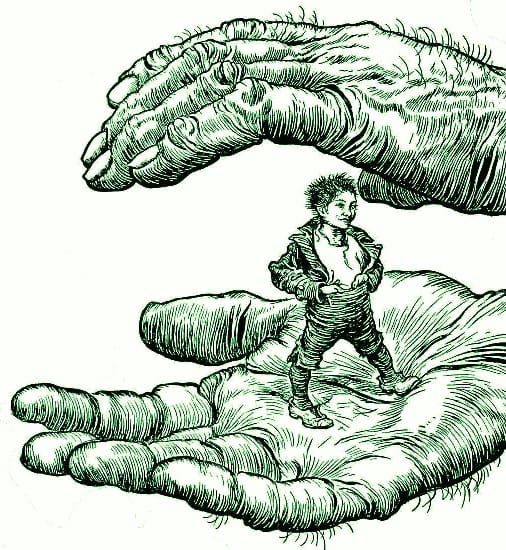
Over at Methods & Madness, Eric Diaz is musing about how much you can cut down the average D&D character's statistic while still covering most of what you have to roll at the table.
He's coming out rather negative at the end:
In the end, this post ended up doing the opposite of what I intended when I wrote its title...
And that's a fair assessment. A regular (A)D&D character has a lot of moving parts, from attribute bonuses to spellls to equipment. If you our your system includes the part that sometimes are managed by the GM, like the to-hit bonus or saving throws, there's even more there. And it'll only grow if the character advances.
On the other hand, I haven't seen that many "solutions" to this problem that didn't leave me wanting. Quite often characters are reduced to their inventory, with a handful of rather universal stat bonuses, plus maybe their level.
So as a small exercise, let me go through some steps and see where I could imagine introducing house rules that simplify things, and where we're just moving beyond my comfort threshold. Will I end up in a similar place as Eric did?
Our starting situation
Eric had this cute image of abridged AD&D character stats based on the toys they made for it ("corpo D&D" wasn't something WotC invented).
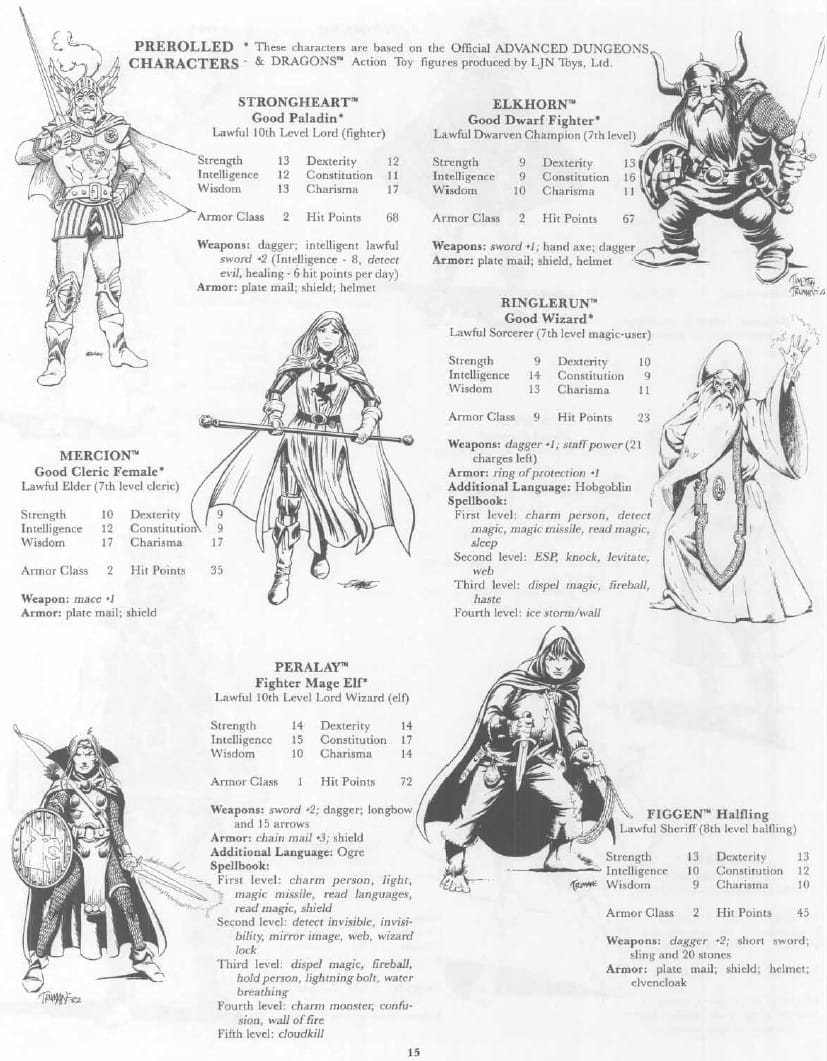
We'll have a look at Peralay, as he's probably the most complex character, being a 10th level Fighter/Mage. Let's clean him up a bit:
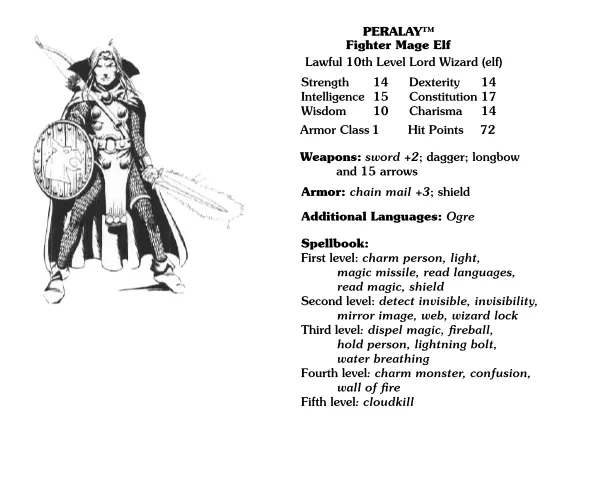
First of all, let's confirm Eric Diaz' complaints: There's a lot here missing. The attributes bonuses, the damage value of the sword, dagger or longbow, the additional languages he gets by being an Elf, attack bonus (either total or to the base level bonus), and what spells he actually has memorized.
We do get some information that hardly seems useful. For example, in AD&D 1E, there's little you can do with the attribute values, besides calculate all the bonuses. All the characters from the toy line seem Lawful anyway, and we get both the level and the Lord Wizard title.
This is all perfectly fine for AD&D. This isn't your reference at the table, but the information you need to fill out your character sheet and do the calculations there.
Correction: As was pointed out to me on Mastodon, the original stat blocks are from XL1 - Quest for the Hearthstone, so already B/X. They're just presented a bit weirdly because they want to sell the Official ADVANCED DUNGEONS & DRAGONS™ Action Toy figures…
A Gentle Massage & Peeling
Let's start by removing a few bits. We're ditching alignments and level titles. We're also moving to a B/X bonus system for abilities and just list that. Moving to a B/X core also means that we don't need to care about weapon damage, it's 1d6 for everything.
But we're adding the saving throws, and a THAC0. 72 hit points is close the maximum a 10th level Elf could have, but we're not commiting totally to B/X (OSE) yet.
Let's also add some blank fields to see how many of each spell you have memorized and the total available per day.
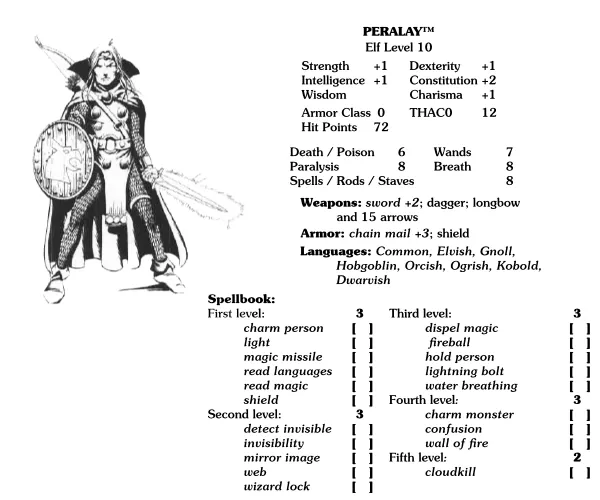
That looks like it's more than previously, but this now is more than just the start of a character sheet, but a document you could use directly to run the game.
The simplification mostly comes from moving from a rough AD&D basis to B/X, a slightly less complex system.
But Wait, There's… Less
We haven't quite reached my personal limits for reducing the core system here. One example where I probably find some common ground even with grognards are saving throws. Further simplification is possible, and Swords & Wizardry did just that. So just like we have a single value for attacks and just modify that by weapon or attack type (melee/ranged), we have one for avoiding danger.
Swords & Wizardry and other retroclones based on the very first D&D edition also reduce the range of ability bonuses. So I'll do that, too, still don't keep the rolled values and will only list adjectives for the ones where you have a bonus (if the characters had particularly low values, I would need to come up with words for that, but thankfully all the toy characters rolled well).
And if abilities just provide a +1 or not, let's do the same for magical equipment. So to see if you get a bonus, you start with your ability and then add every applicable magical item and thus get to your value.
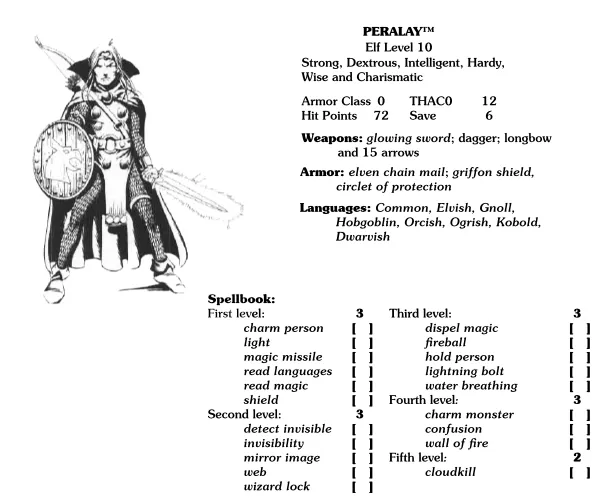
Peralay has a magic sword to attack with and is Strong, thus he gets a +2 bonus to attack in melee. He has three defensive items, and thus his armor class gets a +3 bonus.
What To Do With Magic?
Half the sheet above is still magic. And it's quite likely that you still have to look up spell details, especially if you're more on the AD&D side of things in that regard.
Also note that this is a very short spell list. Realistically speaking, an AD&D character with a 15 Intelligence would have between 7 and 11 spells per spell level, so anything from 35 to 55 total known spells!
And clerics "know" all the spells!
This is also one of my pet peeves when it comes to edition wars. More recent games or even early 2000s third edition might add a lot of new items to the rulebook, but this all recedes into the background when you compare it with the sheer amount of spells, most of which introduce their own tiny bit of rules just for them – and are bound to create an even bigger amount of specific rulings during game play.
But that's also an inherent appeal of the D&D experience – encountering and using a plethora of spells is as much part of the game play as encountering oodles of different monsters. Paring everything down to a half dozen of spells per level or less would seem like playing in a world where there's mostly orcs, goblins and trolls, and not also owlbears, perytons, pegasi, gelatinous cubes, flumphs, and flail snails.
Fewer spells in total and sticking to lower levels sounds like a very charmless solution.
To Cut a Long Story Short…
…I'm quite happy with the modifications I made in the final version above. We're still a bit short of the threshold where it's too disposably NSR-ish to me.
…examining alternative, simpler options for magic that keep with the "true" D&D style is something I should examine later.